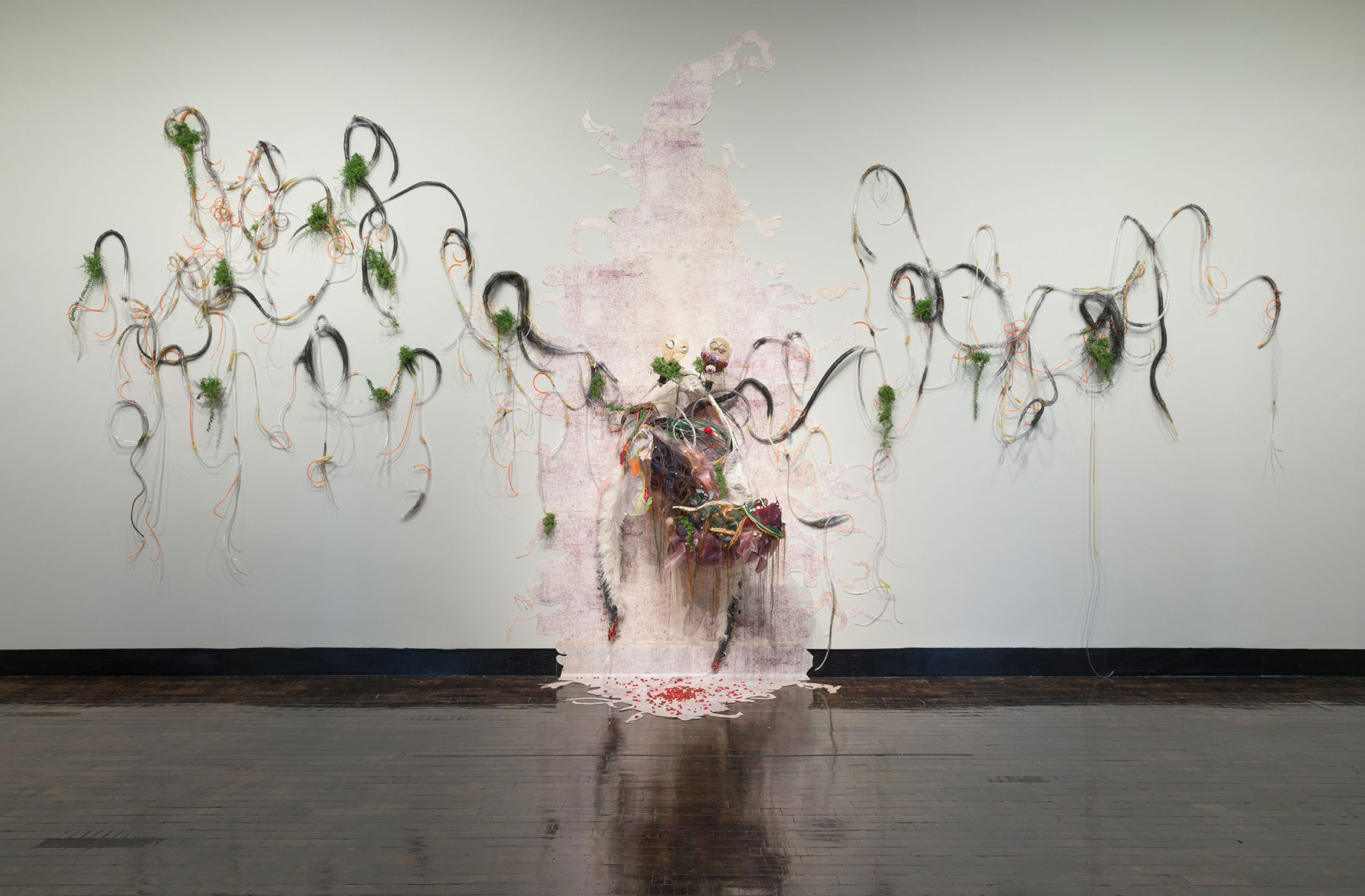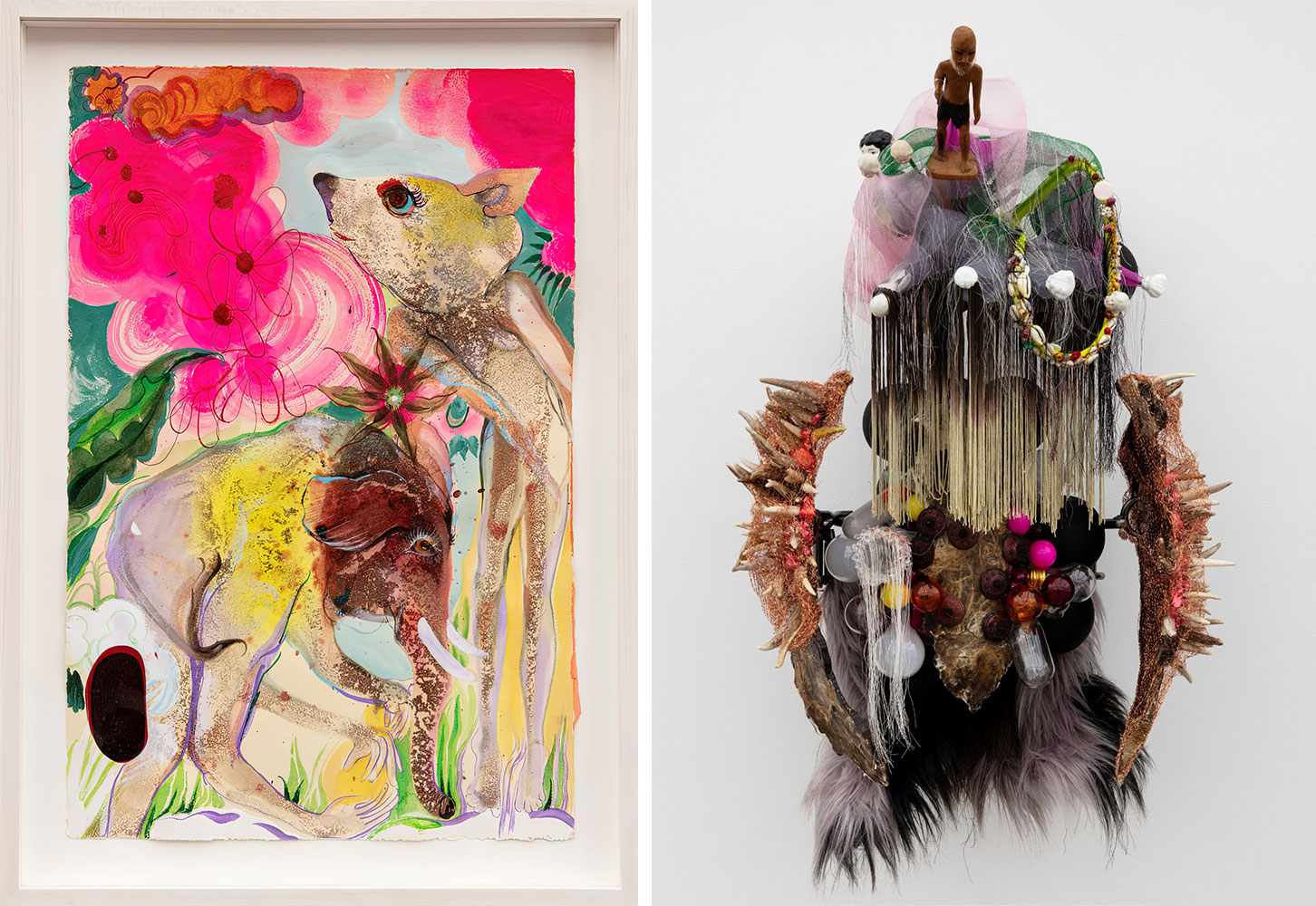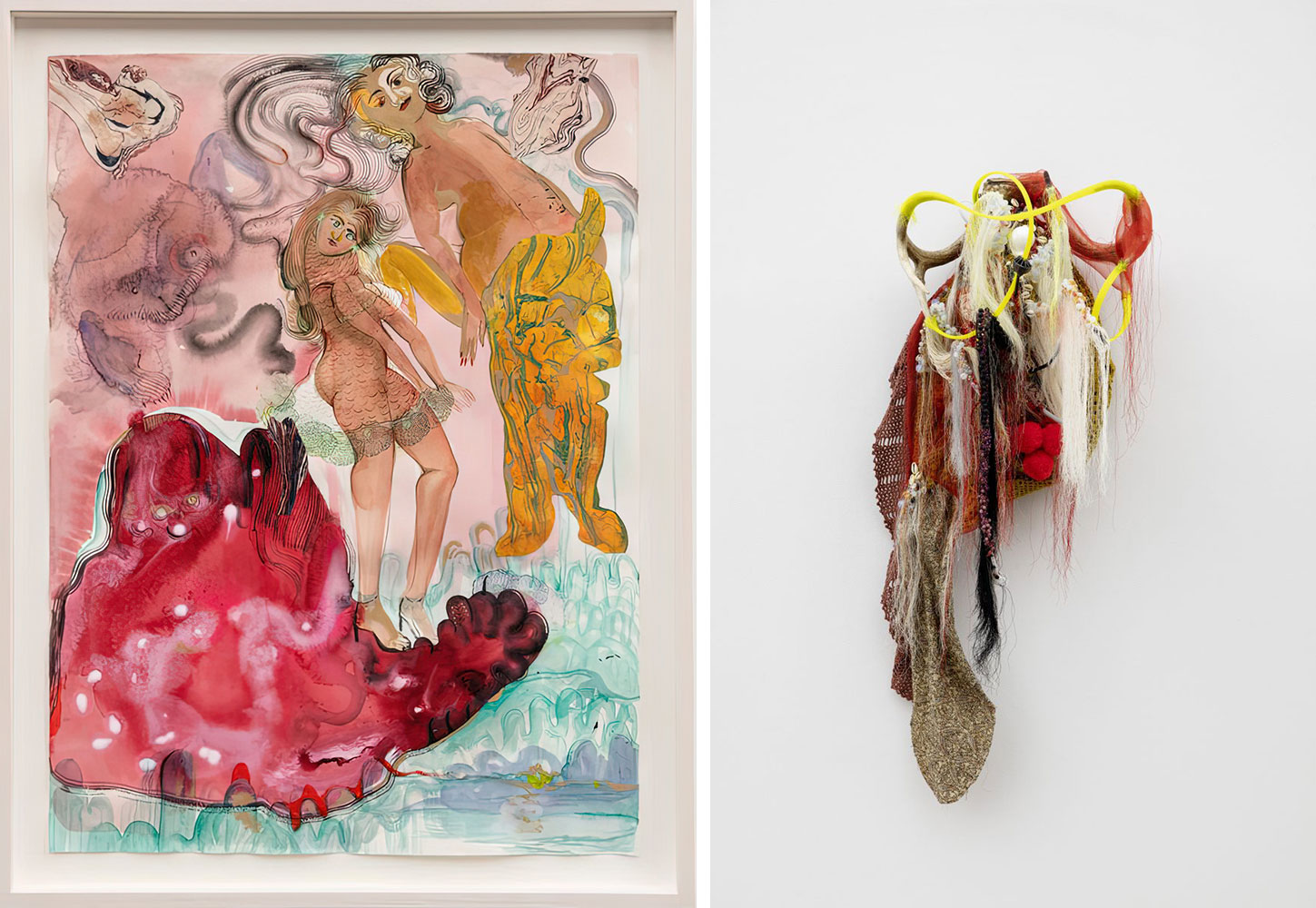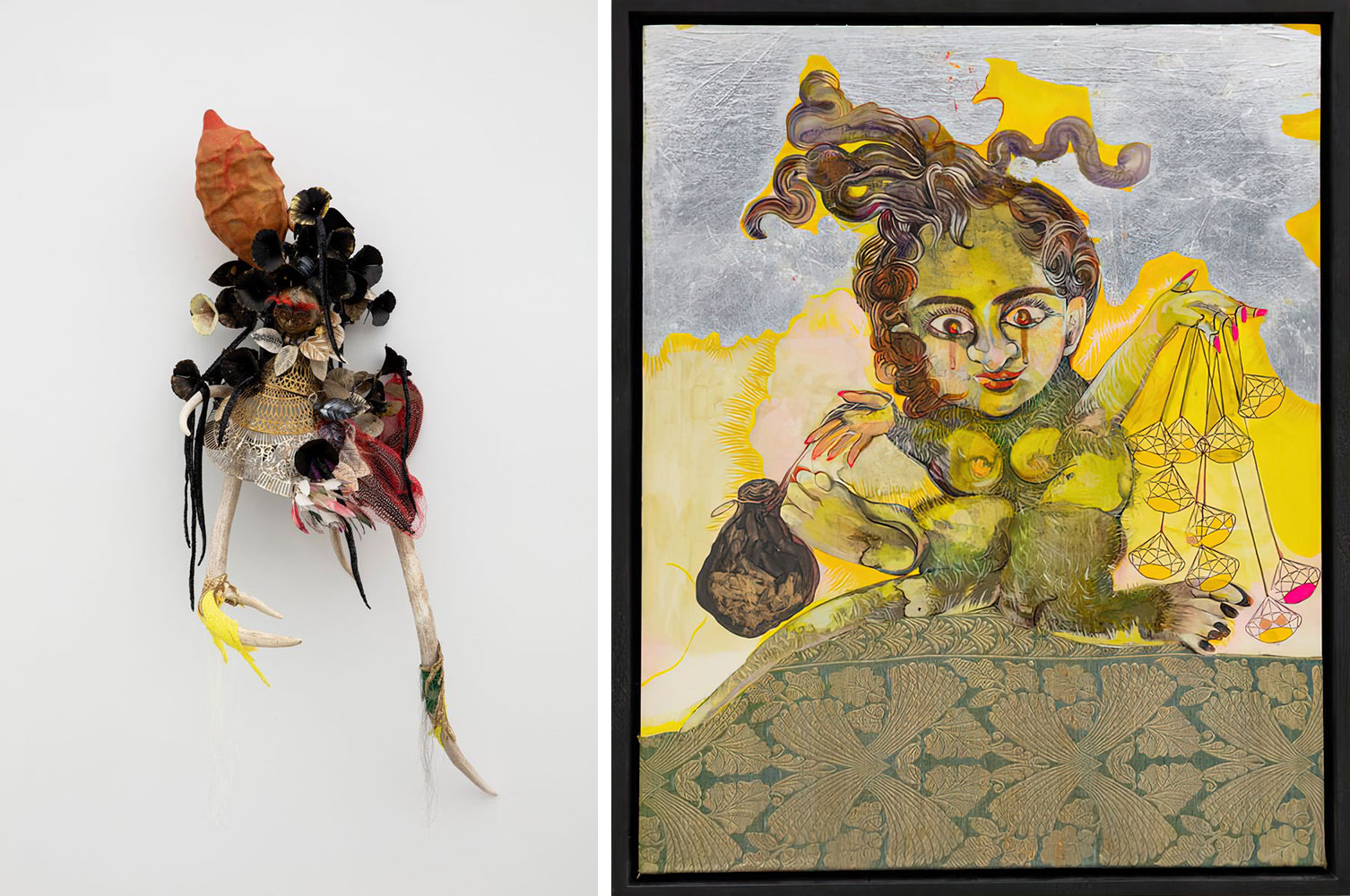ART CITIES: N.York-Rina Banerjee
 Born in Calcutta in 1963, but raised in London and New York, Rina Banerjee’s sculptural assemblages of textiles, fashion items, colonial objects, furnishings, taxidermy and organic materials, sourced from New York junk shops are configured into new and exotic arrangements. Her works have included such unusual materials as taxidermied alligators, wooden cots, fish bones, ostrich eggs, feathers and antique furnishings, forming a visual language steeped in mythology and fairy tales.
Born in Calcutta in 1963, but raised in London and New York, Rina Banerjee’s sculptural assemblages of textiles, fashion items, colonial objects, furnishings, taxidermy and organic materials, sourced from New York junk shops are configured into new and exotic arrangements. Her works have included such unusual materials as taxidermied alligators, wooden cots, fish bones, ostrich eggs, feathers and antique furnishings, forming a visual language steeped in mythology and fairy tales.
By Dimitris Lempesis
Photo: Perrotin Gallery Archive
The exhibition “Black Noodles” brings together both archival and new works, representing Rina Banerjee’s first significant survey in New York City. Banerjee is known for creating artworks that evoke topics of colonization, race, gender, commerce, economics, and migration. These topics span the globe, and Banerjee herself might be imagined as an intrepid voyager. She was born in Kolkata, India in 1963; grew up in Philadelphia and Queens; worked as a research polymer engineer at Penn State; earned an M.F.A. from the Yale School of Art; and has since shown her work prolifically throughout the world—from designing a capsule with fashion house Dior, to representing America at the 55th and 57th Venice Biennales. In this exhibition, “Black Noodles”, mixed-media paintings that hang throughout the space could have been made by a voyager who recorded their encounters with wondrous beings on land and sea. Several of these are on large, buckling pieces of paper, as if Banerjee turned over a map or chart weathered from salty, wet air aboard her ship and jotted down the likeness of a beast she newly encountered. In the resulting works, animals, plants, and human figures dance together in radiant puffs of color, glittering texture, and singular geometries. In this wondrous world, characters seem to have a voice, implied by Banerjee’s titles that use the first-person pronoun, like in a work from 2022, “I am not afraid of you said the Elephant to the Rodent”. Narrating the adventure they are captured in by the artist, these creatures grapple with their world. Is the title of Banerjee’s exhibition, therefore a reference to characters who might figure such a description—hair of Medusa, dark serpents in rivers, eels or squid with long tentacles in the vast deep? Looking at her monumental sculpture “Black Noodles”, we might imagine … once upon a time, a steel propeller from a ship fell into the ocean. It dragged a thousand miles, visiting every shore, drag-netting sand and debris. By the time it finally docked in New York, it looked like a creature. Its metal structure suggests a stomach filled with briny remains. Milk-glass chandelier shades swirl like big fish eyes in the belly of a whale. For decades, Banerjee has developed similar forms that suggest eccentric creatural bodies with the visuals of heterogeneity—the combination of many things—as in Giuseppe Arcimboldo’s 16th-century portrait heads that stack, for example, different fruits or fish together to make a face.The title of her sculpture “Contagious Migrations”, for example, may reference the traffic of people, goods, or disease via colonization, enslavement, immigration, or trade. Banerjee assembled “Contagious Migrations” with everything from luxurious feathers to rubber gloves, heterogeneous materials hanging together in a fine equipoise, and delicately choreographed to suggest the body of some chimerical being. Is that a wildebeest, or the beak of a giant squid emerging from the wall at center? Are there two giant eyes ogling at us? Is the map-like ground on the wall its shedding skin; or is it an atlas of all the shores it visited along a migratory path? Or is this no body at all; just a mere jumble? Like Arcimboldo’s works, Banerjee’s sculptures make uncanny characters that squirm, shapeshift, dissolve, and reform again. Faces barely stick together. Consider the list of materials she used to make “Contagious Migration”: Incense sticks, kumkum, Vaseline, turmeric, Indian blouse gauze, fake fingernails and eyelashes, chalk, foam, feathers, fabric, Spanish moss, incandescent light bulbs, wax, putty, quilting pins, plastic tubing, acrylic, and dry pigment. Banerjee fishes these diverse items from walks, the internet, warehouse shopping trips, and then, once back in her studio, she boils these components in her cauldron with just the right ingredients to conjure these creatures. All of Banerjee’s sculptures on display here indeed have limbs, horns, feathers, or tentacular appendages that activate space as real creatures might, as if the gallery is a menagerie.
Photo: Rina Banerjee, Contagious Migrations, 1999–2023, Incense sticks, kumkum, vaseline, turmeric, Indian blouse gauze, fake fingernails and eyelashes, chalk, foam, feathers, fabric, Spanish moss, light bulbs, wax, Silly Putty, quilting pins, plastic tubing, latex and rubber gloves, acrylic and dry pigment, Dimensions Variable, © Rina Banerjee, Courtesy of the artist and Perrotin
Info: Perrotin Gallery, 130 Orchard street, New York, NY, USA, Duration: 26/4-10/6/2023, Days & Hours: Tue-Sat 10:00-18:00, www.perrotin.com/

Right: Rina Banerjee, In making America, 2020 – 2023, Metal, rice paper, glass, sequins, cotton, horn wire, porcelain and silver leaf,100 x 58 x 55 cm | 39 3/8 x 22 7/8 x 21 11/16 inch, © Rina Banerjee, Courtesy of the artist and Perrotin

Right: Rina Banerjee, Earth as a Company, 2020 – 2023, Hand dyed crochet, electrical casings, cords, marine rope, carpet threads and steel, 110 x 50 x 40 cm | 43 5/16 x 19 11/16 x 15 3/4 inch, © Rina Banerjee, Courtesy of the artist and Perrotin

Right: Rina Banerjee, Lady of Commerce, 2012 – 2023, Hand painted, leaded glass chandelier, wood figurine, vintage glass bottles, chandelier ornaments, birdcage, steel, wood pedestal, lace, cowry shells, taxidermy deer paws, Indian marriage jewelry, ostrich eggshells, porcelain doll hands, silver leaf, gold leaf, wire, linen cord, and marble baby doll hands, 304.8 x 121.9 x 121.9 cm | 120 x 48 x 48 inch, © Rina Banerjee, Courtesy of the artist and Perrotin

Right: Rina Banerjee, Addictions to leaf, 2017 – 2023, Steel armature, feathers, fabric, glass beads, thread, dried gourds and silver leafing, 88.9 x 55.9 x 66 cm | 35 x 22 x 26 inch, © Rina Banerjee, Courtesy of the artist and Perrotin

Right: Rina Banerjee, Cat Burglar, 2022, Painted wood panel, collage silver, gold thread and vintage embroidery, Framed : 54 x 43.2 cm | 21 1/4 x 17 1/4 inch, © Rina Banerjee, Courtesy of the artist and Perrotin
